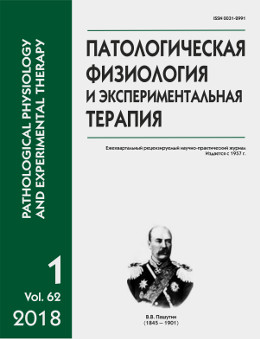Influence of free fatty acids on oxygen consumption by isolated rat cardiomyocytes in ischemic or diabetic heart disease
Abstract
The purpose. To investigate the influence of free polyunsaturated and saturated fatty acids on the oxygen uptake of isolated cardiomyocytes in intact rats and animals with ischemic or diabetic heart disease. Methods. Executed non-randomized controlled study. Considered 3 groups of male rats of Wistar line (weight 250-300 g) with 10 animals in each group. Myocardial infarction ("heart attack") caused by ligation of the left coronary artery, and diabetes ("diabetes") – intraperitoneal injection of streptozotocin. The group "control" was presented intact animals. Myocardial infarction caused by ligation of the left coronary artery, and diabetes by intraperitoneal injection of streptozotocin. Isolated cardiac myocytes were obtained by enzymatic method. Oxygen consumption was assessed polarographically at different saturation incubation medium with oxygen ([O2] 8 mg/l and ([O2] ≥16 mg/l). As the fatty acid used arachidonic and palmitic acid. Results. It was found that in an incubation medium with a high oxygen content, the rate of its consumption by isolated cardiomyocytes, from rat hearts with ischemic or diabetic heart lesions, is 2-2.5 times higher than that in cardiomyocytes from the heart of intact rats. In the introduction of 20 μM arachidonic or palmitic acid into the incubation medium, statistically significantly increased oxygen consumption by cardiomyocytes of intact rats. With simulated pathologies, the opposite result was obtained directly. In a low oxygen incubation medium, a lower initial rate of cardiomyocyte respiration was recorded, irrespective of which group of rats they had been allocated from. The presence of fatty acids led to an even greater decrease in the rate of oxygen consumption by cardiomyocytes of intact rats. In cardiomyocytes from hearts with ischemic lesion, fatty acids reduced the rate of oxygen consumption to practically the values obtained for cardiomyocytes of intact rats. In contrast, fatty acids did not have a noticeable effect on the respiration of cardiomyocytes from the heart rats with diabetic lesions. Conclusion. The results suggest that saturated and unsaturated free fatty acids, on a cellular level, is able to maintain a balance between the flow and the flow of oxygen. The action of the fatty acids is determined by the functional state of cardiomyocytes and oxygen content in the extracellular space. This fact probably affects the energy metabolism of cardiomyocytes in real-ischemic or diabetic heart disease patients.
Downloads
References
2. Velkov V. Free fatty acids - a risk factor for insulin resistance and ischemia: Prospects for risk assessment and diagnosis. Poliklinika. 2008; 4: 50-1. (in Russian)
3. Lopaschuk G.D., Ussher J.R., Folmes C.D., Jaswal J.S., Stanley W.C. Myocardial fatty acid metabolism in health and disease. Physiol Rev. 2010; 90(1): 207-58.
4. Brindley D.N., Kok B.P.C., Kienesberger P.C., Lehner R., Dyck J.R.B. Shedding light on the enigma of myocardial lipotoxicity: the involvement of known and putative regulators of fatty acid storage and mobilization. Am J Physiol. 2010; 298: E897-E908.
5. Chowdhury R., Warnakula S., Kunutsor S., Crowe F., Ward H.A., Johnson L. et al. Association of dietary, circulating, and supplement fatty acids with coronary risk: a systematic review and meta-analysis. Ann Intern Med. 2014; 160(6): 398-406.
6. Mozaffarian D., Lemaitre R.H., King I.B., Song X., Huang H., Sacks F.M. et al. Plasma Phospholipid Long-Chain Omega-3 Fatty Acids and Total and Cause-Specific Mortality in Older Adults: the Cardiovascular Health Study. Ann Intern Med. 2013; 158: 515-25.
7. Van Bilsen M., Planavila A. Fatty acids and cardiac disease: fuel carrying a messagе. Acta Physiol. 2014; 211(3): 476–90.
8. Rebrova T.Yu., Kondratieva D.S., Afanasiev S.A., Barzah E.I. Activity of lipid peroxidation and the functional state of the myocardium during cardiac remodeling in rats after experimental myocardial infarction. Kardiologiya. 2007; (6): 41-5. (in Russian)
9. Afanasiev S.A., Rebrova T.Yu., Kondratieva D.S. Features phospholipid composition of erythrocyte membranes in a myocardial infarction. Biomeditsinskaya Khimiya. 2007; (53): 541-46. (in Russian)
10. Afanasiev S.A., Kondratieva D.S. Popov S.V. Developing a model of comorbidity of heart failure and diabetes mellitus type 1 in the experiment. Bulleten experimentalnoy Biologii i Meditsyny. 2012; (153): 523-26. (in Russian)
11. Egorova M.V., Afanasiev S.A., Popov S.V. A simple method for the isolation of cardiomyocytes from adult rat heart. Bulleten experimentalnoy Biologii i Meditsyny. 2005; 140: 357-60. (in Russian)
12. Egorova M.V, Afanasiev S.A., Popov S.V. Role of phospholipase A2 in the activation respiration of isolated cardiomyocytes under postinfarction cardiosclerosis. Bulleten experimentalnoy Biologii i Meditsyny. 2008; 146: 631-33. (in Russian)
13. Egorova M.V, Afanasiev S.A. The regulatory role of free fatty acids in the maintenance of membrane homeostasis heart mitochondria in experimental myocardial ischemia. Bulleten sibirskoy meditsyne. 2012; (3): 31-8. (in Russian)
14. Aleksandrov A.A. Diabetic heart: Scramble for mitochondria. Consilium medicum. 2003; (5): 509-13. (in Russian)
15. Ashrafian H., Redwood C., Blair E., Watkins H. Hypertrophic cardiomyopathy: a






